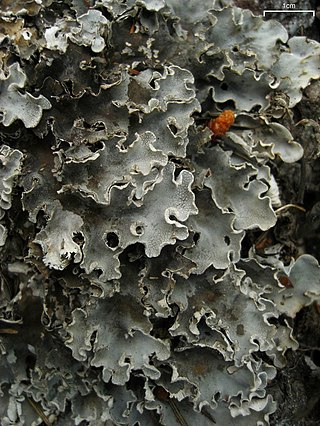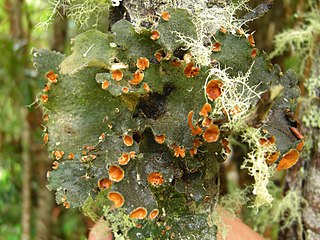
Sticta is a genus of lichens in the family Peltigeraceae. The genus has a widespread distribution, especially in tropical areas, and includes about 114 species. These lichens have a leafy appearance, and are colored brown or black. Sticta species with cyanobacteria as photobionts can fix nitrogen from the atmosphere, and due to their relative abundance and high turnover, they contribute appreciably to the rainforest ecosystem. They are commonly called spotted felt lichens.
Dictyonema hernandezii is a species of basidiolichen in the family Hygrophoraceae. Found in montane rainforests of Costa Rica and in Colombia, it was described as new to science in 2011. The specific epithet hernandezii honours Venezuelan lichenologist Jesús Hernández.
Cora hirsuta is a species of basidiolichen in the family Hygrophoraceae. Found in the páramo region near Bogotá at over 3,000 m (9,800 ft) elevation, it was described as new to science in 2011. The lichen, characterised by its distinctively hairy upper surface and smaller lobes, thrives in a variety of habitats, including soil, bryophytes, and as epiphytes on trees.
Peltigera vainioi is a species of lichen in the family Peltigeraceae. It is found in high-elevation locations in South America. It is a somewhat unusual species in its genus, characterized by a single holdfast that attaches to its substrate, and pores in its cortex.
Acantholichen pannarioides is a species of basidiolichen in the family Hygrophoraceae, and the type species of genus Acantholichen. The lichen has a bluish-tinged, gelatinous thallus with a surface texture that has a powdery to hairy texture. It is found in montane regions of Central America and northern South America, where it grows on forest litter, bark, on bryophytes, and on other lichens.
Peltigera papuana is a lichen-forming fungus in the family Peltigeraceae. It was described in 2009 from Madang Province of Papua New Guinea, which inspired its specific epithet. Genetic analysis of both the mycobiont and the photobiont, which is a Nostoc cyanobacterium, suggests that the evolutionary origin of Pelitgera papuana is from an ancient dispersal event from South America, although this remains inconclusive.
Lobariella sipmanii is a species of foliose lichen in the family Peltigeraceae. It is found in high-altitude páramo in Cundinamarca, Colombia.

Peltigera rufescens, commonly known as the field dog lichen or field pelt, is a species of terricolous (ground-dwelling), foliose lichen in the family Peltigeraceae. This common and widespread species has a cosmopolitan distribution, often found in dry, sunny habitats on basic soils, limestone, and nutrient-rich silicate substrates. The lichen forms rosettes up to 20 cm in diameter, with a grey to brown thallus densely covered with a soft, velvety tomentum. Its lobes, typically 3–5 cm long and 5–10 mm wide, have distinctively curled upward edges. The underside features a network of veins and rhizines, which anchor the lichen to its substrate. P. rufescens reproduces both sexually through apothecia and asexually via regeneration lobes. It forms a symbiotic relationship with cyanobacteria from the genus Nostoc as its photobiont. The species is notable for its ability to bioaccumulate heavy metals and its adaptive responses to UV-B radiation, making it a subject for ecological and physiological studies.
Sticta atroandensis is a species of foliose lichen in the family Peltigeraceae. It is found in the Colombian Andes.
Sticta parahumboldtii is a species of foliose lichen in the family Peltigeraceae. It is found in the Colombian Andes.
Sticta viviana is a species of corticolous (bark-dwelling), foliose lichen in the family Peltigeraceae. It is found in Colombia, where it grows on the branches and twigs of shrubs and treelets in high-elevation páramo habitat.
Peltigera fimbriata is a species of foliose lichen in the family Peltigeraceae. Found in Papua New Guinea, it was formally described as a new species in 2009 by lichenologists Orvo Vitikainen, Emmanuël Sérusiaux, Bernard Goffinet, and Jolanta Miądlikowska. The type specimen was collected between Mt. Sarawaket Southern Range and Iloko village The species epithet fimbriata refers to the characteristic long hairs that occur on the upper thallus surface.
Peltigera granulosa is a species of terricolous (ground-dwelling), foliose lichen in the family Peltigeraceae. Found in Papua New Guinea, it was formally described as a new species in 2009 by Emmanuël Sérusiaux, Bernard Goffinet, Jolanta Miądlikowska, and Orvo Vitikainen. The type specimen was collected from open grassland between Gumum and Sape villages, where it was found growing on sand. The species epithet granulosa refers to its characteristic granulose margin.
Peltigera koponenii is a species of foliose lichen in the family Peltigeraceae. Found in Papua New Guinea, it was formally described as a new species in 2009 by Emmanuël Sérusiaux, Bernard Goffinet, Jolanta Miądlikowska, and Orvo Vitikainen. The type specimen was collected near Lake Wanba at an altitude of 2,400–2,500 m (7,900–8,200 ft), where it was found growing on a tree trunk in an open montane forest of Nothofagus and Pandanus. The species epithet honours Finnish bryologist Timo Koponen, "who made large and well processed collections of Peltigera in Papua New Guinea".
Dictyonema metallicum is a species of basidiolichen in the family Hygrophoraceae. It is found in the montane rainforests of Ecuador. Characterised by its metallic shimmer, it is an epiphytic lichen that spans large areas on host tree trunks and frequently extends to adjacent bryophytes. Its unique visual texture is created by the loosely interwoven dark blue fibrils of the thallus, a thin, compressed filamentous layer, accentuated by a silver prothallus.
Ocellularia vizcayensis is a rare species of corticolous (bark-dwelling) lichen in the family Graphidaceae. It is known from a single collection made in Luzon, Philippines. The lichen thallus is a white, irregularly structured, areolate surface with a layer that includes a photosynthetic partner, both containing large calcium oxalate crystals. Its fruiting bodies are either embedded or protruding, round, with very narrow openings, and contain large, oblong, colorless spores that turn violet-blue when stained with iodine.

Peltigera cinnamomea, commonly known as the cinnamon-pelt lichen, is a muscicolous (moss-dwelling), leafy lichen in the family Peltigeraceae. The Canadian lichenologist Trevor Goward formally described the species in 1995. The lichen is found in northwestern North America's forested regions, particularly in the unique montane and subalpine forest communities of the northern Rocky Mountains. Peltigera cinnamomea grows under prolonged snow cover, surviving well into spring. This trait distinguishes it from many other Peltigera species in similar North American forest ecosystems.

Peltigera castanea is a species of terricolous and muscicolous, foliose lichen in the family Peltigeraceae. Described as a new species in 2003, it is part of the taxonomically challenging species complex centred around Peltigera didactyla. Recognised based on phylogenetic studies that highlighted its unique genetic markers, P. castanea is distinguished by its dark, chestnut-coloured upper surface, which inspired its vernacular name, chestnut pelt lichen. Its known distribution includes North America, Asia, Europe (Estonia), Greenland, and the Antarctic. The conservation status of Peltigera castanea varies regionally, from being critically imperiled in British Columbia and Yukon to critically endangered in Estonia due to significant habitat degradation and restricted population size.
Yoshimuriella peltigera is a species of corticolous (bark-dwelling), foliose lichen in the family Peltigeraceae. It occurs in neotropical mountainous rainforests.

Pseudocyphellaria hirsuta is a species of foliose lichen in the family Peltigeraceae. First described in 1835, it has undergone several taxonomic revisions over nearly two centuries. The lichen forms a flat, leaf-like structure (thallus) that can grow up to 27 cm in diameter, typically appearing grey or brown and covered in fine hairs. It is characterised by small pore-like structures called pseudocyphellae on its lower surface, which can be yellow or, less commonly, white. P. hirsuta grows mainly on trees in forested areas, particularly those dominated by southern beech (Nothofagus) species, but can also be found on rocks, soil, and stumps. The species is widely distributed in Argentina and Chile, from central regions to Tierra del Fuego, and has been observed in various forest types and elevations.




